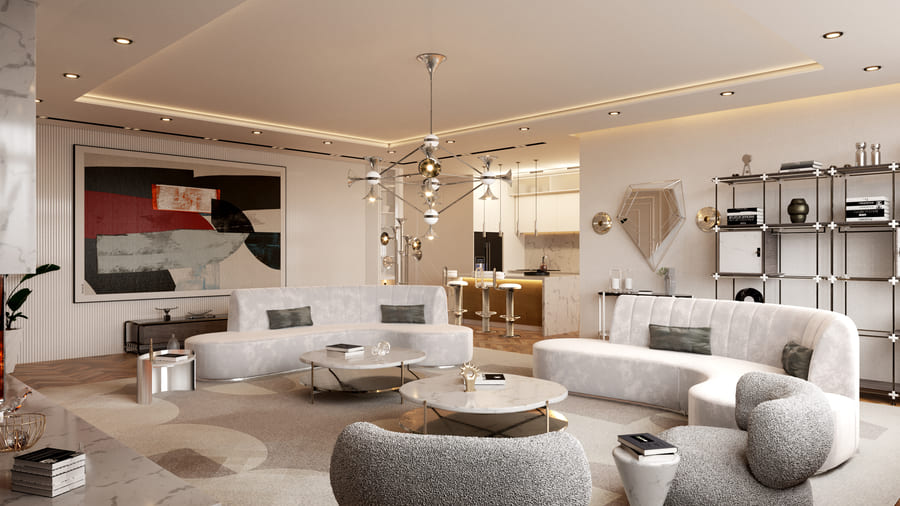
Beyond Aesthetics: The Art and Science of Transformative Interior Design
Interior design is often mistaken for a simple act of decoration—choosing a paint color, picking out furniture, and hanging art. While these elements are part of the process, true interior design is a far more complex and impactful discipline. It is the art and science of understanding people’s behavior to create functional, aesthetically pleasing spaces within a building. A well-designed interior can do more than just look good; it can enhance our quality of life, improve our mental health, and boost our productivity. It’s a holistic practice that blends architecture, psychology, and creative vision to shape the environments where we live, work, and play.
In today’s world, where our homes have become our offices, gyms, and sanctuaries, the importance of thoughtful design has never been more apparent. It’s about creating a narrative, a personal ecosystem that supports our daily routines, reflects our personalities, and nurtures our well-being. This comprehensive guide will delve into the foundational principles of interior design, explore its modern evolution with technology and wellness, and provide actionable insights for transforming your own space. From mastering the flow of a room to integrating sustainable practices, we will uncover how to create interiors that are not only beautiful but also deeply resonant and life-enhancing.
The Foundational Pillars of Exceptional Interior Design
Before diving into specific styles or trends, it’s crucial to understand the core principles that govern all well-designed spaces. These timeless rules are the language of design, enabling the creation of rooms that feel balanced, harmonious, and intuitive. Mastering them is the first step in any successful Home Improvement or design project, whether you’re undertaking a full renovation or a simple refresh.
Space Planning and Functional Flow
Space is the canvas of interior design. Effective space planning involves more than just placing furniture; it’s about orchestrating a room’s layout to optimize function and flow. Designers consider both positive space (areas filled with objects) and negative space (empty areas) to create a sense of balance and prevent a room from feeling cluttered or sparse. Key considerations include:
- Traffic Patterns: How do people move through the space? Clear, unobstructed pathways are essential for comfort and usability, especially in high-traffic areas like kitchens and living rooms. A common best practice is to allow at least 30-36 inches for major walkways.
- Zoning: In open-plan living, zoning creates distinct functional areas. An area rug can define a seating area, a console table can separate a living room from a dining space, and pendant lighting can anchor a kitchen island. This approach is vital for maintaining a sense of Home Organization and purpose in multi-use rooms, which is critical for a healthy Work-Life Balance when working from home.
- Scale and Proportion: The size of furniture relative to the room and other objects is critical. A large, overstuffed sofa can overwhelm a small room, while tiny furniture can feel lost in a cavernous space. The goal is to create a harmonious visual relationship between all elements.
The Psychology of Light and Color
Light and color are arguably the most powerful tools for influencing the mood and perception of a space. Their application goes far beyond simple aesthetics, directly impacting our Mental Health and even our Sleep Health.
Color Theory: Colors evoke emotional responses. Blues and greens often create a sense of calm and are ideal for bedrooms and bathrooms, promoting relaxation and Stress Management. Warmer colors like reds and yellows are energizing and can stimulate appetite and conversation, making them suitable for dining rooms and kitchens. A neutral palette can provide a serene backdrop, allowing texture and form to take center stage, a key principle in Minimalism.
Layered Lighting: A single overhead fixture is rarely sufficient. Professional design relies on a layered lighting strategy:
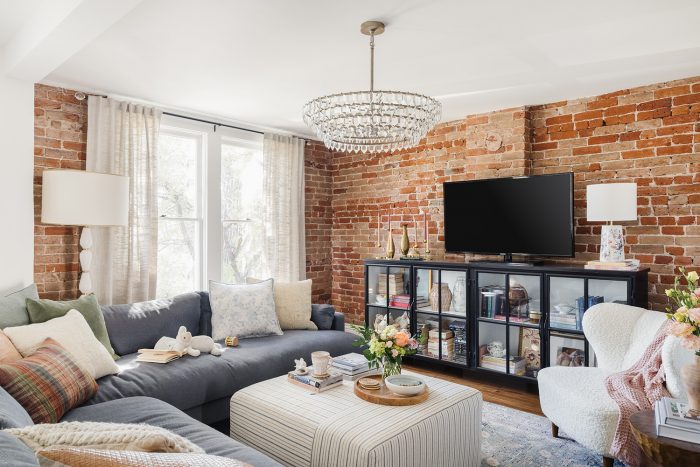
- Ambient Lighting: The general, overall illumination of a room (e.g., recessed lights, chandeliers).
- Task Lighting: Focused light for specific activities like reading or cooking (e.g., under-cabinet lights, desk lamps). Good task lighting is one of the most important Productivity Tips for a home office.
- Accent Lighting: Used to highlight architectural features or artwork (e.g., track lighting, picture lights).
Harnessing natural light is also paramount. Maximizing daylight not only reduces energy consumption but has been proven to improve mood and well-being, a cornerstone of holistic Health & Wellness.
The Importance of Texture, Pattern, and Materiality
A room designed with only flat, smooth surfaces can feel sterile and uninviting. Texture adds depth, interest, and a tactile dimension. This is achieved by mixing materials like rough-hewn wood, smooth metal, soft velvet, and chunky knit wool. Pattern, whether in wallpaper, textiles, or tiles, introduces rhythm and personality. This is also where Sustainable Living comes into play. Choosing materials like reclaimed wood, bamboo, cork, and recycled glass not only adds unique character but also promotes an Eco-Friendly Living ethos.
The Modern Evolution: Integrating Wellness and Technology
Interior design is not a static field. It continuously evolves to reflect societal shifts, technological advancements, and a deeper understanding of human psychology. Today, two of the most significant drivers of design innovation are the integration of smart technology and a focus on wellness-centric principles.
The Rise of the Smart Home and Integrated Technology
Technology for Home is no longer an afterthought; it’s a fundamental layer of modern design. The goal of a well-designed Smart Home is not to showcase gadgets, but to create a seamless, intuitive, and responsive environment. This includes:
- Automated Lighting and Climate Control: Systems that adjust lighting color temperature and brightness throughout the day to mimic natural circadian rhythms can significantly improve Sleep Health. Smart thermostats learn your habits to optimize comfort and energy efficiency.
- Integrated Audio and Entertainment: Hidden speakers and centralized media systems reduce visual clutter, aligning with principles of Minimalism and creating immersive experiences for entertainment.
- Enhanced Home Security: Smart locks, cameras, and sensors can be discreetly integrated into a home’s design, providing peace of mind without compromising aesthetics.
The key is to ensure technology serves the inhabitant, simplifying life and enhancing comfort rather than complicating it. This requires careful planning during the initial design phase to hide wiring and integrate devices seamlessly.
Biophilic Design: Reconnecting with Nature for Better Health
Biophilia is the hypothesis that humans possess an innate tendency to seek connections with nature. Biophilic design applies this concept to the built environment, and its benefits are well-documented, contributing to reduced stress, increased creativity, and improved overall well-being. This is a core tenet of Holistic Health in modern design.
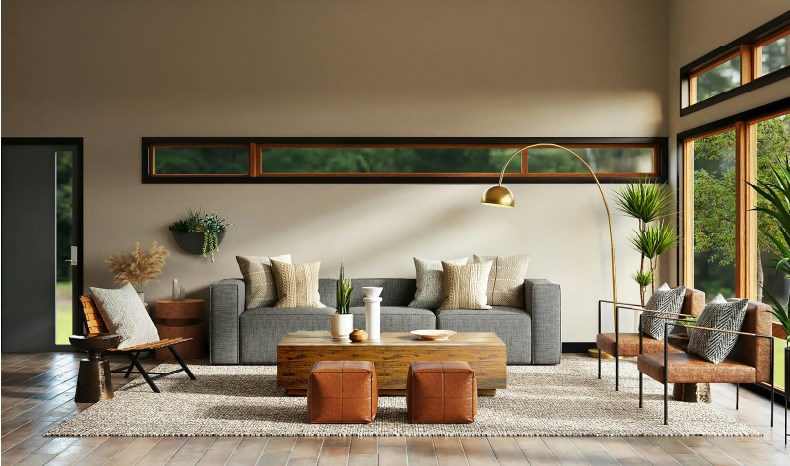
Real-World Application: A biophilic home office might feature a large window with views of greenery, a living wall of plants, furniture made from natural wood, and materials that mimic natural patterns. Incorporating houseplants is a simple yet powerful form of biophilia, offering practical Plant Care and Urban Gardening opportunities. This connection to nature fosters a calming environment conducive to focus and mental clarity, directly impacting Work-Life Balance.
From Concept to Reality: A Practical Guide to the Design Process
Understanding design theory is one thing; applying it is another. Whether you’re embarking on a DIY Projects adventure or hiring a professional, following a structured process is essential for success and staying on budget.
Step-by-Step: The Professional Design Workflow
- Define the Scope and Vision: Start by asking “why.” What is the primary function of the space? How do you want to feel in it? Gather inspiration images to create a mood board. This initial phase is about self-discovery and setting clear goals.
- Budgeting and Financial Planning: This is a critical step. A detailed budget should account for furniture, materials, labor, and a contingency fund (typically 10-15%) for unexpected costs. This is where sound Personal Finance skills and creating a list of Budget Tips are invaluable. Decide where to invest (e.g., a quality sofa, a comfortable mattress) and where you can save.
- Space Planning and Layout Development: Measure your space accurately and create a floor plan. Use painter’s tape on the floor to map out furniture placement to get a real-world feel for the scale and flow before making any purchases.
- Sourcing and Selection: This is the phase where you select specific furniture, lighting, textiles, and finishes. Always order samples for paint, fabric, and flooring to see how they look in your home’s unique lighting conditions. For those interested in Sustainable Fashion, applying the same principles to sourcing furniture—looking for vintage, second-hand, or ethically made pieces—can be a rewarding approach.
- Execution and Installation: This is where the plan comes to life. If you’re managing the project yourself, create a timeline and coordinate deliveries and tradespeople. If you’ve hired a designer, they will manage this process for you.
Common Pitfalls and How to Avoid Them
- Ignoring Scale: As mentioned, this is a frequent mistake. Always measure your room and potential furniture pieces before buying.
- Following Trends Blindly: Trends are fleeting. It’s better to invest in timeless, classic pieces for large items like sofas and beds, and incorporate trends through smaller, less expensive accessories like pillows and throws.
- Poor Lighting: Relying on a single overhead light fixture is a recipe for a flat, uninviting room. Always plan for layered lighting.
- Lack of a Cohesive Plan: Buying items piecemeal without an overall vision can result in a disjointed space. Stick to your initial mood board and color palette.
The Future of Home: Recommendations and Forward-Thinking Trends
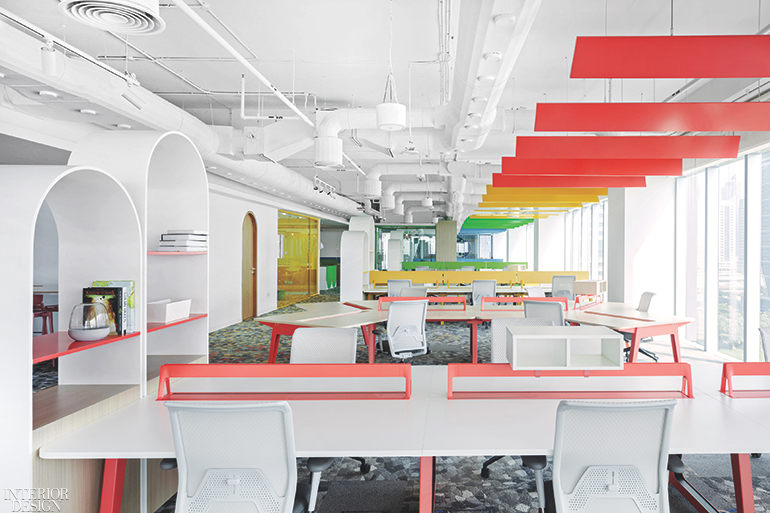
As our lifestyles evolve, so too does the world of interior design. Looking ahead, several key trends and philosophies are shaping the way we will live in our homes, moving towards more flexible, sustainable, and personalized environments.
Key Trends Shaping Our Future Spaces
- Multi-Functionalism: The era of single-purpose rooms is fading. With the rise of Remote Work, spaces must be adaptable. A dining table may also be a desk, and a guest room might double as a yoga studio. Furniture that is modular, movable, and multi-purpose will become increasingly essential.
- Hyper-Personalization: Design is moving away from cookie-cutter looks toward spaces that are deeply personal expressions of the inhabitants’ lives, values, and experiences. This includes displaying personal collections, custom-built furniture, and incorporating items from travel that tell a story.
- Sustainability as a Standard: What is now a trend will become a baseline expectation. This means a greater emphasis on using non-toxic, renewable, and recycled materials, as well as designing for energy efficiency and longevity to reduce waste, aligning with a Zero Waste philosophy.
Actionable Recommendations for Every Homeowner
Whether you’re starting from scratch or looking to make small improvements, here are some final tips:
- Start with Decluttering: Before adding anything new, remove what isn’t working. Effective Decluttering and Organization Tips can instantly make a space feel larger and more serene.
- Invest in Key Pieces: Prioritize your budget on the items you use most, such as your sofa, bed, and dining table. Quality pieces will last longer and provide greater comfort.
- Don’t Be Afraid of DIY: Painting a room, changing hardware, or building simple shelves are accessible DIY Projects that can have a massive impact without a huge financial investment.
- Trust Your Instincts: Ultimately, your home should be a reflection of you. While design principles provide a valuable framework, the most important rule is to create a space that you love and that supports your life.
Conclusion: Crafting a Home That Nurtures and Inspires
Interior design is a powerful discipline that fundamentally shapes our daily experiences. It is a thoughtful blend of art and science, aesthetics and function, psychology and practicality. By understanding its core principles—space, light, color, and texture—and embracing modern evolutions like smart technology and biophilia, we can move beyond mere decoration. The goal is to create intentional, responsive environments that support our health, enhance our productivity, and provide a true sanctuary from the outside world. A well-designed home is not a luxury; it is a vital component of a balanced and fulfilling life, a personal backdrop that nurtures our well-being and tells the unique story of who we are.
Archives
- December 2025
- November 2025
- October 2025
- September 2025
- August 2025
- October 2023
- September 2023
- August 2023
- July 2023
- June 2023
- May 2023
- April 2023
- March 2023
- February 2023
- January 2023
- December 2022
- November 2022
- October 2022
- September 2022
- August 2022
- June 2022
- May 2022
- April 2022
- March 2022
- January 2022
- December 2021
- November 2021
- October 2021
- August 2021
- November 2020
- July 2020
- May 2020
- April 2020
- March 2020
- August 2018
- July 2018
- June 2018
- April 2018
- March 2018
Categories
- Age Groups
- AI/ML
- Alternative Medicine
- Animal Health
- Animal Husbandry
- Animals
- Anti-Aging
- Architectural Design
- Auditory Science
- Augmented Reality
- Automation
- Babies
- Baby
- Beauty & Skincare
- Biohacking
- Biomechanics
- Book Reviews
- Breastfeeding
- Budgeting
- Budgeting Strategies
- Business
- Cardiovascular Health
- Career Advice
- Career Development
- Career Growth
- Cats
- Chess
- Chronobeauty
- Circular Economy
- Cleaning Tips
- Cloud Computing
- Cognitive Health
- Cognitive Performance
- Cognitive Science
- Community
- Community Building
- Community Engagement
- Community Living
- Computer Vision
- Consumer Guides
- Consumer Trends
- Container Gardening
- Content Analysis
- Content Non-Technical
- Content Strategy
- Cosmetic Chemistry
- Cultural Events
- Cycling
- Data Analysis
- Data Engineering
- Data Science
- Design Psychology
- Developer Productivity
- Diet
- Diet
- Digital Identity
- Digital Media
- Digital Wellbeing
- DIY Projects
- Dogs
- Engineering Culture
- Entertainment News
- Environmental Impact
- Environmental Science
- Equity Compensation
- Ethical AI
- Exercise
- Exercise Science
- Exercise Technique
- Exotic Pets
- Fall Gardening
- Family
- Family Health
- Family Life
- Fashion Business
- Fashion Industry
- Fashion News
- Fashion Tech
- Financial Analysis
- Financial Optimization
- Financial Planning
- Flooring Maintenance
- Food
- Food Psychology
- Food Safety
- Food Tech
- Functional Fitness
- Functional Training
- Future Of Work
- Garden Care
- Garden Maintenance
- Gardening Tips
- Greece
- Greek
- Greek Food
- Gymnastics
- Hardware Engineering
- Health
- Health And Wellness
- Health Informatics
- Health Science
- Health Tech
- Healthcare Management
- Healthy Eating
- Healthy Recipes
- Holistic Health
- Holistic Wellness
- Home & Living
- Home Decor
- Home Financing
- Home Health
- Home Improvement
- Home Organization
- Horticulture
- Identity Management
- Industrial Design
- Industry Analysis
- Infant Nutrition
- Infrastructure Management
- Ingredient Deep Dive
- Integrative Health
- Integrative Medicine
- Interior Design
- Internet of Things
- Internet of Things (IoT)
- Invalid Request
- Investment Strategies
- Investment Strategy
- IoT
- Kids
- Leadership Development
- Learning Strategies
- Lifestyle
- Lifestyle Brands
- Lifestyle News
- Lifestyle Optimization
- Literary Criticism
- Literature
- Logistics Management
- Material Science
- Materials Science
- Meal Planning
- Media Analysis
- Meditation
- Mental Health
- Mental Performance
- Mental Wellness
- Miami
- Miami Food
- Mind And Body
- Minimalism
- Mobile Development
- Neuroscience
- No Applicable Categories
- Nutrition
- Nutrition News
- Operating Systems
- Operational Resilience
- Opinion
- Organization Tips
- Outdoor Living
- Over 40
- Over 50
- Over 60
- Parenting
- Parenting
- Parenting Strategies
- Performance
- Personal Development
- Personal Finance
- Personal Growth
- Personal Productivity
- Pet Care
- Pet Safety
- Philosophy
- Politics
- Productivity
- Protein
- Psychology
- Psychology of Space
- Reading Culture
- Real Estate Investment
- Recipes
- Regulatory Compliance
- Remote Work
- Renovation Planning
- Resource Management
- Responsible Pet Ownership
- Retail Strategy
- Robotics
- Science
- Seafood
- Seasonal Gardening
- Security
- Self-Care
- Skincare Science
- Skincare Trends
- Sleep
- Sleep Health
- Smoothies
- Social Impact
- Soft Skills
- Soil Health
- Spatial Computing
- Spatial Design
- Stress Management
- Supplements
- Sustainability
- Sustainability Science
- Sustainable Engineering
- Sustainable Fashion
- Systems Engineering
- Tax Optimization
- Tax Strategy
- Tech Investment
- Travel
- Travel News
- Travel Safety
- Travel Tips
- Trend Analysis
- Uncategorized
- Urban Planning
- User Experience
- Veggie
- Virtual Events
- Volunteering
- Wealth Management
- Wearable Technology
- Wellness
- Wellness Technology
- Work-Life Balance
- Workplace Culture
- World
- Writing
- Writing Skills
- Yoga News
- Zero Waste



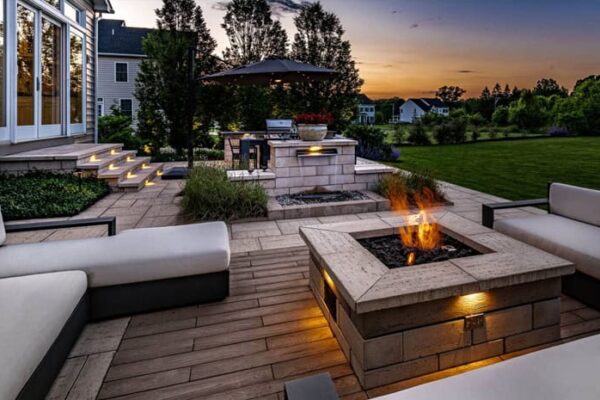
Leave a Reply